While we’re motoring along on riveting, I’ll share a cool graphic I cobbed from Perihelion Design, who in turn snagged it from an old issue of Popular Mechanics.
 I wonder when Garmin will start making cockpit pen plotters?
I wonder when Garmin will start making cockpit pen plotters?

While we’re motoring along on riveting, I’ll share a cool graphic I cobbed from Perihelion Design, who in turn snagged it from an old issue of Popular Mechanics.
 I wonder when Garmin will start making cockpit pen plotters?
I wonder when Garmin will start making cockpit pen plotters?
We spent last weekend celebrating Ellen’s birthday by taking a skiing trip to Stowe, VT with our good friends Burt and Liz. Conditions at Stowe were great in the morning…
That’s Burt in the lower left foreground of the iPhone panorama. Click on the pic for a larger version. If you have an iPhone 4s or better and haven’t played with the camera’s Panorama function, you’re missing out on a lot of fun!
Ellen and I had a great time…
Meanwhile, we’re still banging out the final rivets on the forward fuselage, hopefully we’ll be done by the end of the weekend.
More to follow…
We made some serious progress on the fuselage this weekend!
On Friday, Ellen and I finished backriveting all the smaller rivets on the forward skins. After crawling out from under the fuse, I found some graffiti.
I mangled a couple of rivets because we were rushing, hence some related graffiti…
And those of you who speak German will recognize the wordplay on this bad rivet…
And on Saturday, my friend and fellow RV builder Captain John came over and we drove all the AD4 rivets (big rivets, for you who aren’t airplane geeks) left in the forward fuse. A few hours of work yielded a lot of progress. Here’s the pilot’s side…
John and I also shot the remaining baggage area rivets where I had previously experimented with Hysol to fill some gaps between skin layers. These bends came out a lot better than expected, certainly worth the mess and time it took to apply the liquid shim…
Captain John did a hell of a job bucking the AD4 rivets. They’re pretty damn close to perfect.
Another picture? Sure, why not?
I had to remove the AN3 bolts blocking some rivets in the firewall corner gusset; that’s the center right area in the picture above. Getting those reinstalled and torqued was a little bit of a challenge, but I managed to frankenstein together a torque wrench extension that worked pretty well.
We’re on to the final stretch…just a few more rivets on the belly and longerons, and it’s canoe-flipping time!
For the first time since migrating the site to WordPress, I checked the WP dashboard’s comment spam logs. Found some pretty good ones…
The last major task on the fuselage canoe was getting the forward belly skin in place. That, in turn, meant mixing up some nasty, gloppy Flamemaster CS1900 firewall sealant to seal the firewall-to-skin joints.
This stuff is a pain to work with…it has a consistency something like taffy, and it doesn’t adhere very well to stainless steel. Its only redeeming characteristic is that it’s one of the few sealants capable of withstanding the 1000 deg F temperatures the firewall is supposed to protect us against in the (hopefully extremely) unlikely event of an engine compartment fire.
Before troweling this stuff on, I un-clecoed the side skins and pulled them back to expose the firewall side flanges. I also pre-positioned the belly skin just above the firewall (big thanks to Mike Bullock for posting his sealing process, I copied it verbatim). The blue painter’s tape is there to keep me from making a complete mess of everything else behind the firewall.
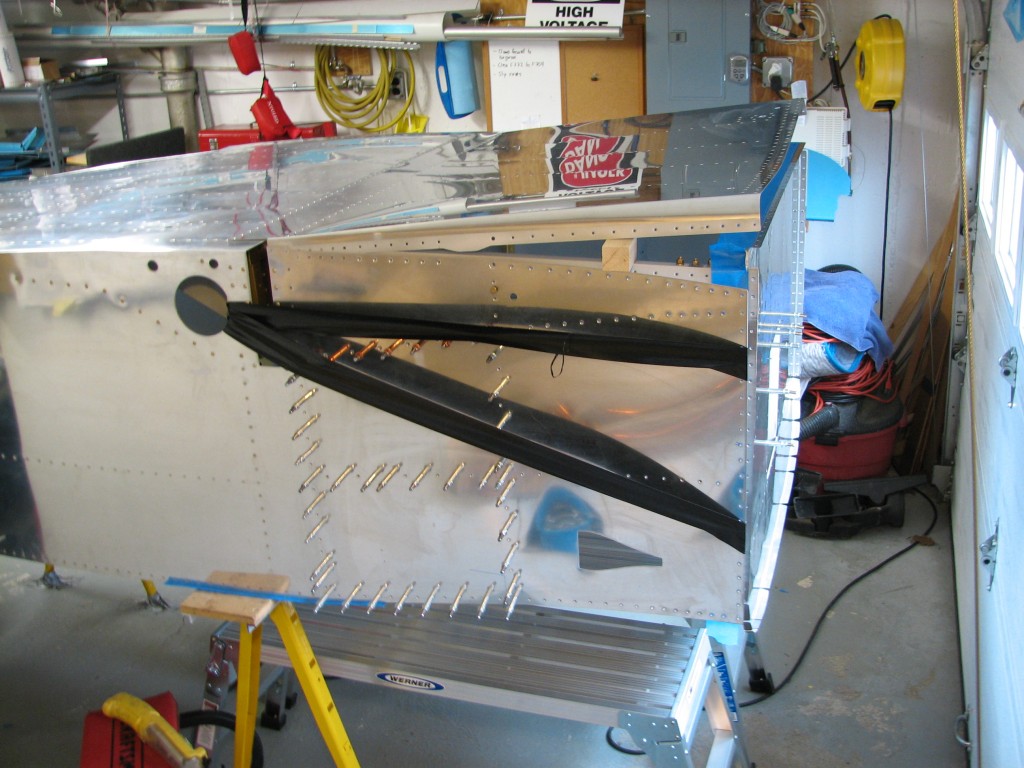 This stuff doesn’t spread well…if you don’t apply a lot of pressure to smooth it out, it stays “lumpy”, for lack of a better word. Here’s what it looks like when applied…it’s actually smoother than it looks.
This stuff doesn’t spread well…if you don’t apply a lot of pressure to smooth it out, it stays “lumpy”, for lack of a better word. Here’s what it looks like when applied…it’s actually smoother than it looks.
Here’s the final result, with a few side rivets set for good measure.
So I was reading some posts on Van Air Force about shims and using a flexible epoxy called Hysol as a “liquid shim” in areas where the skin-to-structure fit isn’t so good. So as an experiment I bought some Hysol EA9394 from SkyGeek and tried it out, first on the conical bends at the rear baggage compartment floor.
The stuff comes in a two-part pack. After I mixed it up, I troweled it into a syringe…
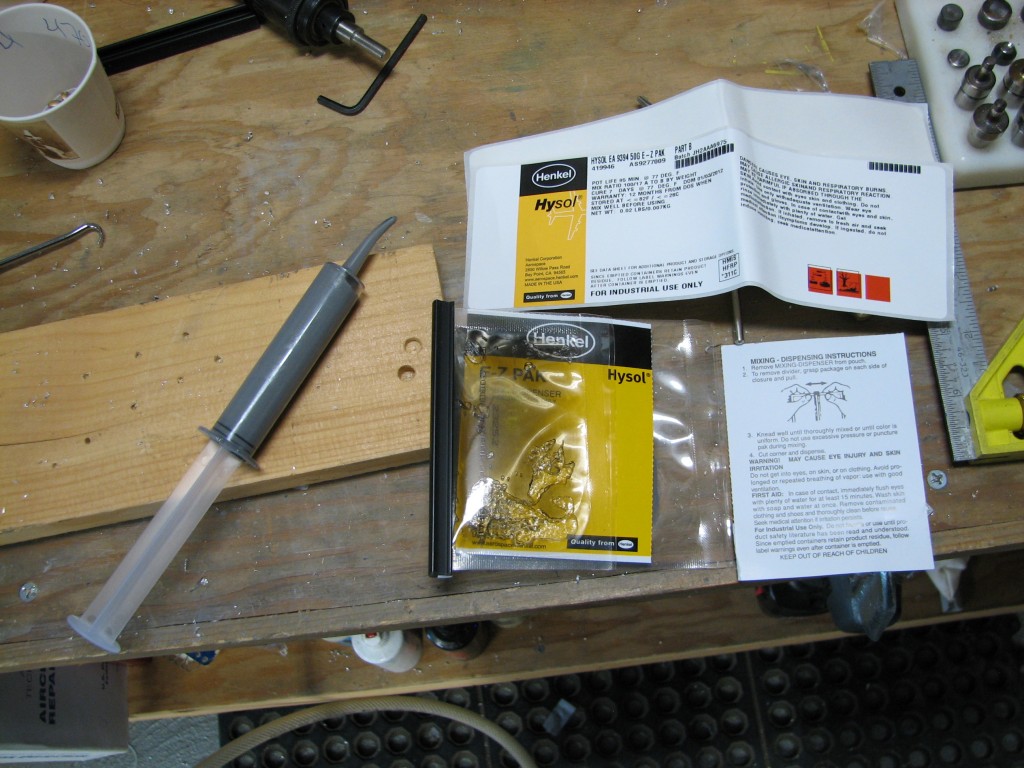 …and injected it into the areas around the conical bend where the aft skin tabs don’t nest so well into the center skins. The Hysol should fill any gap between the tab and skin, hopefully preventing big dimples when the rivets are set.
…and injected it into the areas around the conical bend where the aft skin tabs don’t nest so well into the center skins. The Hysol should fill any gap between the tab and skin, hopefully preventing big dimples when the rivets are set.
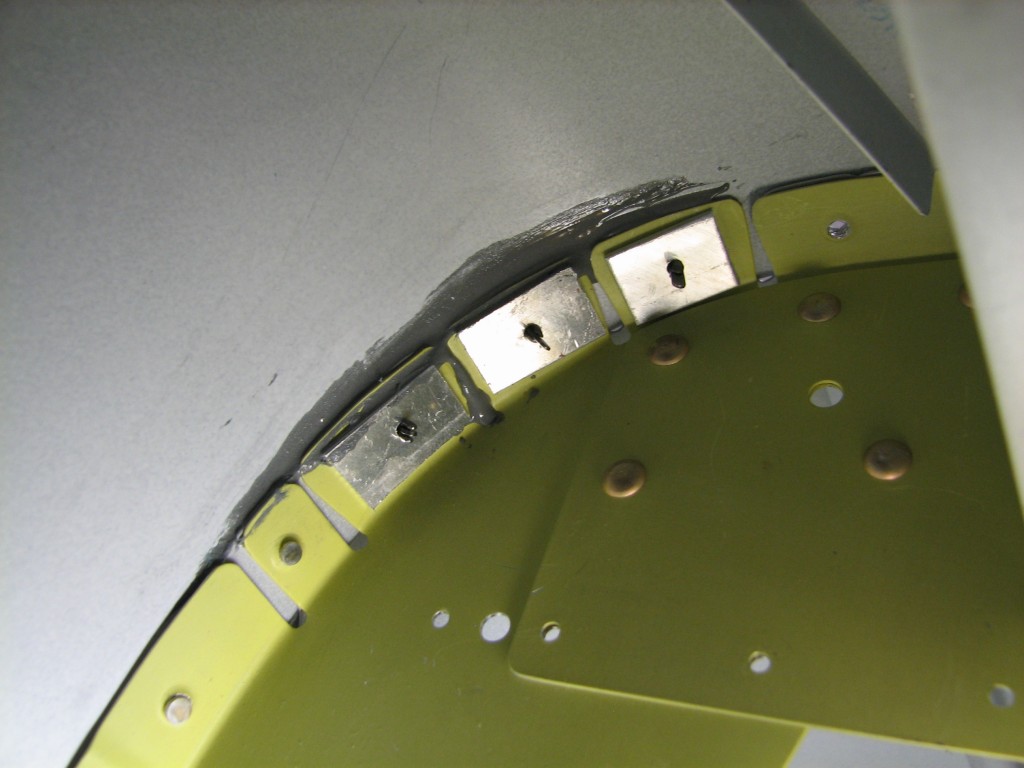 I had a little Hysol left over, so I shot some into the gaps left by poorly-fitting aux longerons in the forward fuse. Vans makes these parts by joggling the ends, which means that some areas don’t fit so well.
I had a little Hysol left over, so I shot some into the gaps left by poorly-fitting aux longerons in the forward fuse. Vans makes these parts by joggling the ends, which means that some areas don’t fit so well.
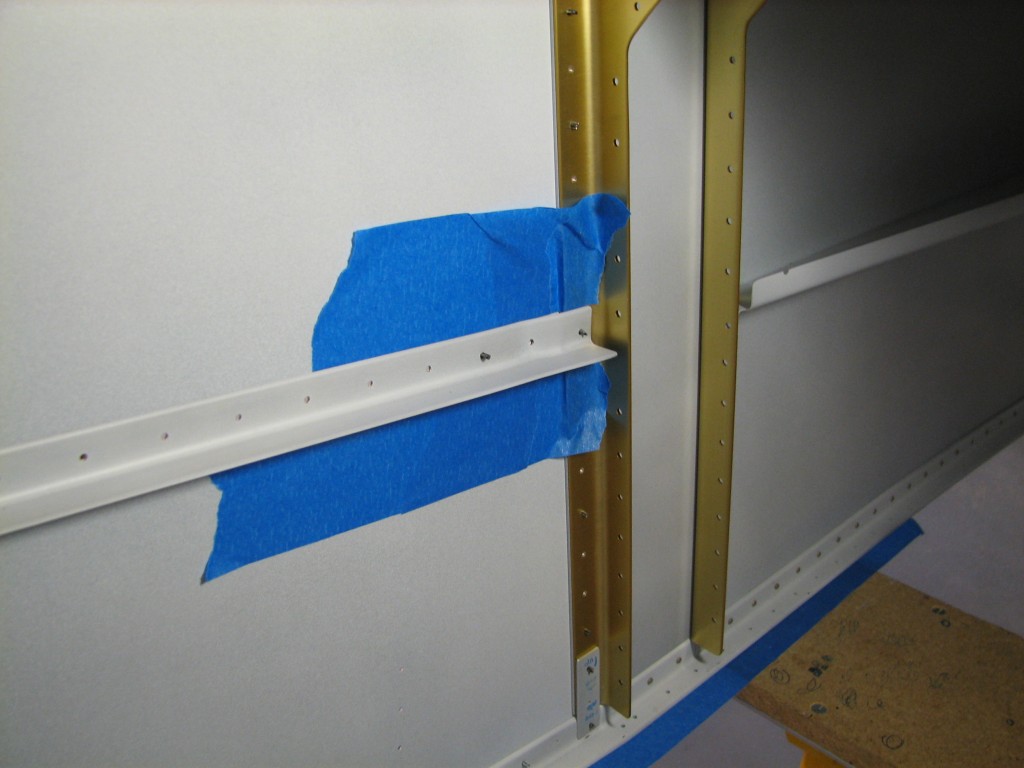 The proof will be in how the skins look when we rivet them…I hope this wasn’t a waste of a day.
The proof will be in how the skins look when we rivet them…I hope this wasn’t a waste of a day.
It’s Saturday and after the blizzard it’s 20 degrees outside and we have two feet of snow in the driveway.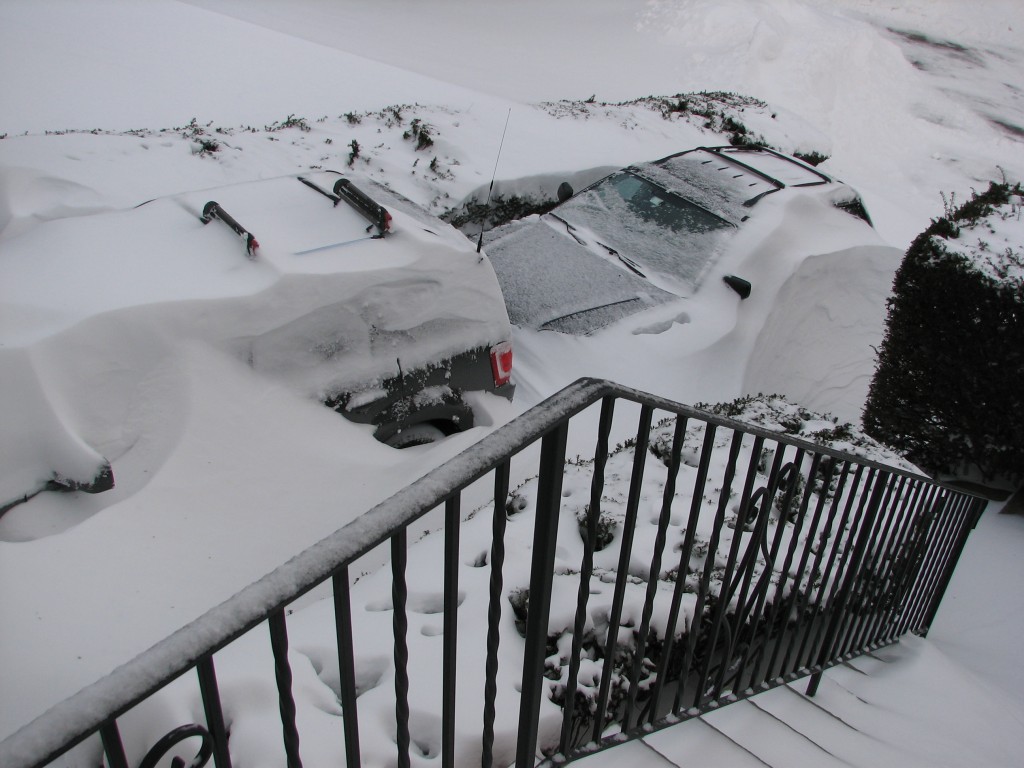 So do we bundle up and dig out the cars, or do we stay warm and dry and work on the RV? That’s an easy question to answer.
So do we bundle up and dig out the cars, or do we stay warm and dry and work on the RV? That’s an easy question to answer.
First thing we did was finish riveting two of four of the front floor stiffeners. I was able to squeeze most of the rivets, but a couple required the classic buck/shoot method – no problems.
After finishing the stiffeners we moved on to fuselage side and belly skin rivets. Some we were able to back-shoot, for others Ellen ran the rivet gun and I bucked. We had a few rivets to drill out, but we made good progress. The tungsten bucking bar is worth every penny I paid for it…made short work of some difficult-to-reach rivets.
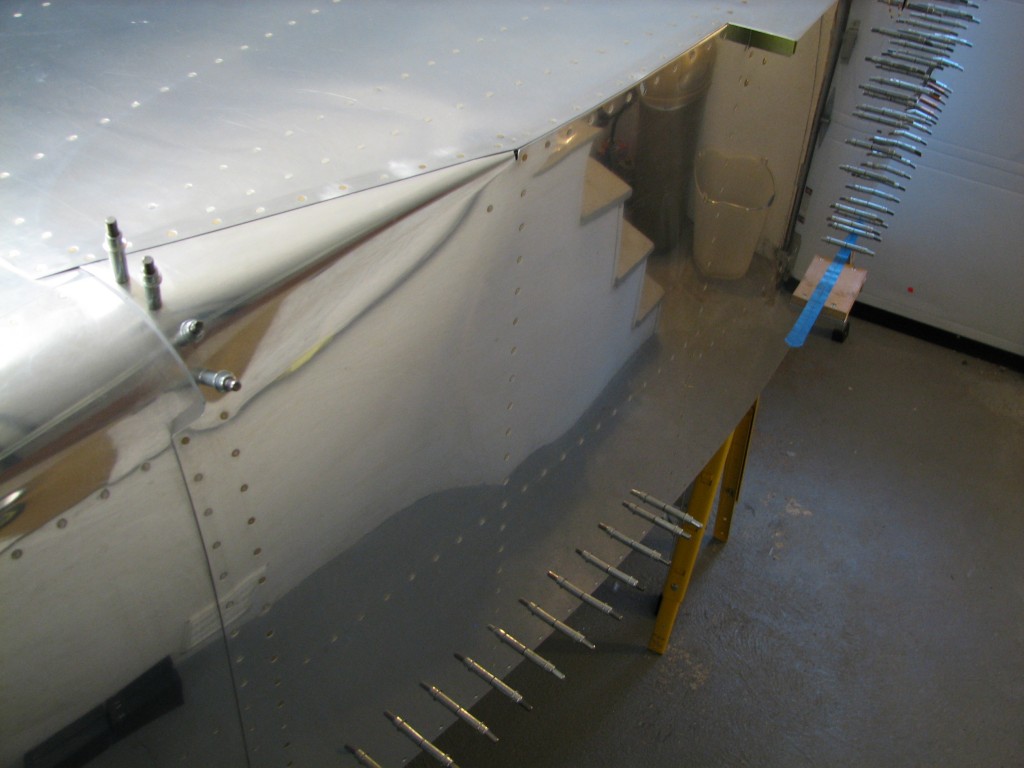 I’m especially happy that we got most of the rivets done in the baggage floor where the side skin curves into the belly. Considering how much of a pain it was to get the side skins bent to the proper curve and fitted to the belly skin, this area came out really well. Once again, Ellen did a wonderful job with the rivet gun!
I’m especially happy that we got most of the rivets done in the baggage floor where the side skin curves into the belly. Considering how much of a pain it was to get the side skins bent to the proper curve and fitted to the belly skin, this area came out really well. Once again, Ellen did a wonderful job with the rivet gun!
Another picture? Sure, why not…
We probably can’t avoid shoveling snow tomorrow morning, but after we do we’ll be back at work on the fuse right side. We’re getting really close to flipping the fuse “canoe.”
After a quick round-robin trip to Delaware to deliver our daughter back to college, Ellen and I got in a short riveting session this afternoon before the Super Bowl. We did all the aft tailcone longeron rivets, including the “keeper” rivets that secure the longerons until the aft upper skins are installed. As usual, Ellen did a great job running the rivet gun.
One more thing…the walnut stick grips from Pioneer Aircraft arrived. I really like the look and feel of these grips, and the switches have a nice, solid feel.
Guy at Pioneer was a pleasure to work with, and I’m looking forward to using the grips.
Happy New Year! The project has taken a back seat to other priorities over the last few weeks, but today I had the opportunity to fix a problem that has been bugging me for awhile.
Seems that when I drilled the lower firewall weldments to the large longerons that support them, I managed to mis-drill a couple of the holes so that they weren’t perpendicular to the longeron, making it impossible for a bolt and nut to seat correctly around the hole.
I guess I’m not the first person to make this mistake, since there were a couple of threads on Vans Air Force on how to fix this sort of problem. The solution of choice is to fabricate some angled shims or washers that allow the bolt head and locknut to be fully supported.
Here’s the shim I fabricated for the forward hole, there’s another one just like it on the underside of the joint. As you can see, the hole was pretty far off perpendicular.
The aft hole wasn’t so bad, I was able to grind a couple of AN960 washers to serve as shims.
Here are a couple of pictures of the end result. I’m not proud of the screwup in the first place, but the fix worked well and I’m happy with how it came out.
Now it’s back to riveting!